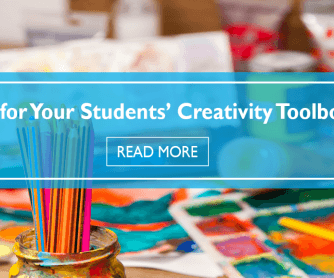Creativity is not just an art - it takes place within policy making, game strategizing, problem solving and lesson planning. It’s a long process that comes in many forms, starting from the right idea and turning it into something tangible. A lot of revision is expected in each draft with the goal of finding the perfect product at the end.
Everyone can be creative in his or her own way. Scientists, althetes, and other professionals all use their own form of creativity. As teachers, you have the role of determining how a student can be creative and helping to build the skills to bring it out. You can do that by building your student's creativity toolbox. Below are some tools needed for the student’s creative toolbox. Put them into practice and the students will learn how to work on them by themselves.
Think Up Many Ideas
Creativity is a process which starts with a single idea. However, no one should settle for the first idea when it may be possible to generate more great ideas. Students can complete activities such as Chalk Talk or Affinity Mapping to share their ideas with otehrs and receive feedback. Then students can choose the best ideas and drop the others.
Revise an Idea, Solution, or Concept
Once chosen, an idea should go through many faces. It's wise to revise an idea from various perspectives, such as the audience, cultural considerations, and the viewpoints of supporters and critics. This will esnure that the final idea is accepted by all groups of people. This process can involve other people if their input would be helpful to create the best possible idea. An idea may start out baseless and meaningless, but can become amazing when shaped with the help of multiple people.
Become Involved in Structured Conversations
Give students a chance to talk to others about their ideas. The more they talk about an idea, the better they understand it and become at explaining it. As they explain the idea to others, they may recognize certain aspects tht need more work and other aspects that stand out and should be focused on.
Engage in Trial and Error
The best idea comes from making mistakes. Flaws create a better opportunity of coming up with something better or gaining a better approach of achieving the target. Trial and error creates perfect solutions to problems because it shows that what did not work out had other ways of dealing with it. A student cannot learn without making some mistakes hence they should be encouraged not to feel lost when an idea fails to work as expected.
Set an Idea Aside for Marination
Don’t work on the same idea every day. It is good to take time to rest and focus on other things. Giving the idea some space will help students approach the idea with a fresh perspective and will make their revisions more effective.
Keep a Portfolio or a Journal
Keeping a collection of the drafts students have created or having them keep a journal of their thoughts and questions can help them develop their idea into something much stronger. Sometimes earlier drafts may include components that make more sense later on and earlier questions can be answered better once more of the idea has taken shape.
Conduct Research
When building an idea, students should conduct research related to the concept. They can learn from the research they complete and may discover aspects of the idea which they have not previously considered.
Focus
It’s important for students to focus in the direction they want to go. By avoiding distractions and negative influences, students can achieve their goals. Offer them sound advice and don't let them be discourage by negative peer pressure or other naysayers.
Enlarge your students' creativity by teaching them a few of these tools. They will help students develop stronger ideas in many subject areas, from art to science, history, and athletics.
Author Bio:
Emma Alex is a teacher. Currently, She’s working with smiletutor.sg. Her writing and speaking center on inspiring quality and character in students, specifically through project-based learning, original scientific and historical research, service learning, and the infusion of arts.
P.S. If you enjoyed this article, please help spread it by clicking one of those sharing buttons below. And if you are interested in more, you should follow our Facebook page where we share more about creative, non-boring ways to teach English.








